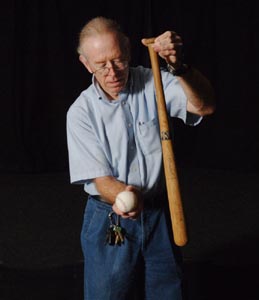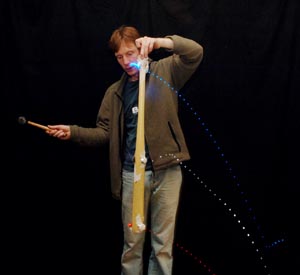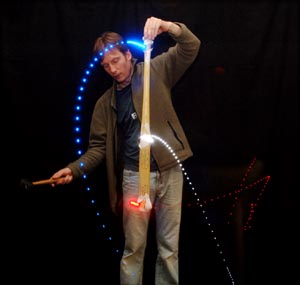
Hold the bat loosely in two fingers then strike the bottom of the bat firmly and rapidly with the ball. Click to enlarge.
Baseball Bats
The Sweet Spot #1 The Center of Percussion, COP
Introduction
A baseball bat has a couple of "sweet spots"; one of them is called its "center of percussion" (COP). That's physicist talk for the point where the ball's impact causes the smallest shock to your hands. If you hit a baseball closer to the bat's handle than to the center of percussion, you'll feel a slight force pushing the handle back into the palm of your top hand. If you hit the ball farther out than the COP, you'll feel a slight push on your fingers in the opposite direction, trying to open up your grip. But if you hit the ball right on the COP, you won't feel any force on the handle. To find the COP on a bat, try this simple activity.( Here we are not referring to the vibration of the bat, but to the "jump" of the bat handle in your hand.)
Material
• A bat
• A ball
• A friend
When you hold a bat with your hands at the bottom of the handle (a normal grip), the COP is located about six to eight inches from the fat end of the bat. If you choke up on the bat, the COP moves closer to the fat end. That's because the location of your top hand is the place you want the bat to pivot. Changing your hand's position on the bat changes where that pivot point is, which therefore changes the position of the COP to one that corresponds to the new pivot point.
To Do and Notice
To find the COP on a bat, hold the knob on the handle end of the bat gently in two fingers. Have a friend hit the bat with a ball. Start hitting at the end farthest from your hand then move down the bat. Hit the bat with a strong force from the ball.

. Notice how the bat feels in your hand as the ball hits it. When we tried this at the Exploratorium, we could feel both a vibration and a force pushing on our hands. The amount of vibration and "push" varied, depending on where on the bat the ball hit. Some of us found it a little hard to distinguish between the two feelings, but if you can, the COP is where you feel the smallest push on your hand.

What's Going On?
A bat is essentially a long stick. When you hit a stick off center, two things happen: The entire stick wants to move straight backward, and it also wants to rotate around its center. It's this tendency to rotate that makes the bat's handle push back on or pull out of your hands.
When the ball hits the bat's COP, you don't feel a push or pull as the bat tries to spin. That's because when the bat spins, it pivots around one stationary point. When you hit a ball at the COP, the stationary point coincides with where your top hand is. So your hand feels no push one way or the other.
This is important if you want to hit the ball a long way. Every time you hit a ball at a point that's not the COP of your bat, some of the energy of your swing goes into moving the bat in your hands, not to pushing the ball so that it moves away from your farther and faster. If less of the bat's energy goes to your hands, more of it can be given to the ball.
Going Further
We attached some blinking LEDs to a baseball bat. The LEDs blinked 100 times per second. We then hung the bat as loosely as we could in our fingers and hit it with a rubber mallet. The white light is placed at the center of mass of the bat.
Notice what happens when we hit the bat at its center of mass.

When hit at its center of mass the bat stays vertical as it moves to the side and falls under gravity to the floor. The blue light at the top of the bat moves to the right. Click to enlarge.
Notice what happens when we hit the bat at its bottom.

When hit at its bottom the bat pivots about a point near its center of mass. The blue light at the top of the bat goes to the left. Click to enlarge.
|
Scientific Explorations with Paul Doherty |
|
11 February 2007 |